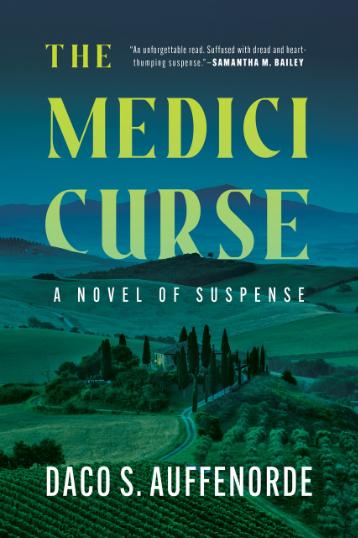
7 minute read
CLAIRE CONSIDERS The Medici Curse by Daco S. Auffenorde
CLAIRE CONSIDERS The Medici Curse by Daco S. Auffenorde
A splendid gothic thriller with the perfect blend of the supernatural, The Medici Curse (Scarlet 2025) by Daco S. Auffenorde offers readers everything they might want from a thriller—and then some more. It’s an atmospheric, mysterious, often intense, and always captivating novel centered around Anna, a young woman trying to find peace and answers in Italy, her home country, after many years away. Anna is also trying to find a family heirloom, a valuable necklace that many believe is cursed. Anna’s mother, famed opera singer Vittoria de’ Medici Rossi, was wearing the necklace the night she fell to her death, and it has not been seen since.
Anna’s quest for the necklace is further complicated by the lingering question of what happened to her mother the night she died. Anna was there, but she was a child and does not remember. Her father whisked her away to America soon after the tragedy, but who he was protecting—her or himself—remains another mystery. There are still those, including some cousins, who believe Anna pushed her mother to her death.
The necklace in question is known as the Medici Falchion, and it is described as having three tiers of rubies and diamonds. The whereabouts of this lost necklace serve as a driving force in the plot, as does the question of whether the curse is real or merely superstition.
Anna, whose full name is Anna Maria de’ Medici Rossi, is Vittoria’s only child, and she returns to her family villa in Italy both to further her career as an artist and to find the long-missing necklace. She believes she will never feel whole until she finds it, and she also suspects it is hidden somewhere in the villa. Anna and her relatives hold differing views on whether the Medici Falchion is truly cursed. Even Anna fluctuates in her suspicions.
As author Daco S. Auffenorde explains: “Anna hopes that if she can find and destroy the necklace, she can escape the madness of her past. And the only place the missing heirloom could be is hidden within the house itself.” Unfortunately for Anna, the villa is filled with labyrinths of dark corridors, secret rooms, and underground caverns.
This Italian villa, which Anna has inherited, is described as a classic Italian Renaissance estate, and it becomes very much a character itself. At times, the house seems to possess a personality, appearing in turns benevolent or malevolent. Anna recalls her mother once saying, “All houses have souls, just like people.” Whether this house’s soul is good or evil remains in doubt, just as the question of the curse remains a propulsive puzzle.
Without question, the villa has a haunting, chilling quality, with an underlying sense of danger. Yet it is also a place of great beauty, filled with precious memories for Anna. It holds crucial clues, hidden in its many rooms, secret spaces, and especially in the basement and the caves connected to the mansion.
Auffenorde, a Huntsville, AL, lawyer and author, explains: “In Gothic novels, houses are not merely settings; they become central to the atmosphere and themes of the story. The house evolves into a character of its own, with its features often reflecting the fears and conflicts of the characters.”
The author also says: “To create a house that evokes dread and fear, reflecting the emotional and psychological states of the characters, essential elements like dark, cold, and oppressive spaces, hidden corridors, and secret rooms become natural candidates for inclusion in a story. These areas within the house amplify the characters’ vulnerabilities—their sense of being cut off from the world and trapped. The many rooms, hidden spaces, and labyrinthine passages reflect Anna’s inner turmoil—her struggle to uncover truth and reconcile with her past. The basement and caves are significant, as they hide crucial clues about the dark secrets of her family’s history. And sometimes, the house and its furnishings feel like a prison to Anna.”
It is also significant, Auffenorde explains, that Anna is the last surviving direct descendant of her family, and she feels disconnected from the distant relatives who confront her upon her return to Italy. She has not seen these cousins since she was twelve, and she doesn’t know who she can trust.
Readers can expect to feel the rising tensions and fears as Anna searches among the many hidden spaces and disturbs more than memories. Somebody clearly does not want her to continue her exploration of the villa. But whether it is ghosts, jealous cousins, the mysterious caretaker, or an old friend—Anna doesn’t know who is endangering her. Nor will the readers until the climactic conclusion.
Her cousins operate a vineyard that Anna owns and which they use as if it were theirs. The conflicts deepen over the vineyard when Anna refuses to sell it to the family, even after they claim her father had promised it to them. Thus, the cousins clearly want her land—and they might want the Medici Falchion as well. But how far will they go to claim either, or both? And who among the family might be the real threat?
Auffenorde excels in creating characters—especially Anna—but also the local citizens and distant relatives who populate the Italian setting. One handsome, seductive cousin seems alternately charming and sinister, while a childhood friend and other cousins vacillate in their behavior toward Anna, further confusing her and adding more mystery to the plot.
Complicating issues of trust, Anna is repeatedly confronted with questions about Edoardo, the elderly caretaker of the villa. Things don’t add up where he is concerned. Yet she can hardly deny her fondness for him and what appears to be his genuine regard for her. But is he really who he purports to be?
Like the villa itself, it’s hard for Anna to decide whether the caretaker is good or evil. Confronted with such questions—and with apparent hostility from those around her—Anna comes to worry about her own sanity. Is she being gaslighted? Is she losing her grip? Is the villa haunted? Is the necklace cursed?
As the story moves rapidly along, with expert pacing, Anna searches for the necklace, fends off her extended family, struggles with her own heightened anxieties, confronts the consequences of a risky night of passion, and possibly endures a haunting. Bad things happen. Then worse things happen. Anna is seriously injured, becoming dependent on people who might be friends—or foes. Auffenorde excels at crafting artful false villains and unreliable allies, pulling readers into an edge-of-your-seat quest to discover what happens next.
There’s an amazing level of suspense throughout this novel, but readers should not overlook how well the sentences flow to create a rich reading experience. For example, Auffenorde’s lyrical descriptions of the vineyards in Italy are so lush that they add to the sheer pleasure of reading the book. As Anna observes: “Mature Chianti grapevines with rich canopies of leaves and full clusters of grapes are nature’s work of art.”












